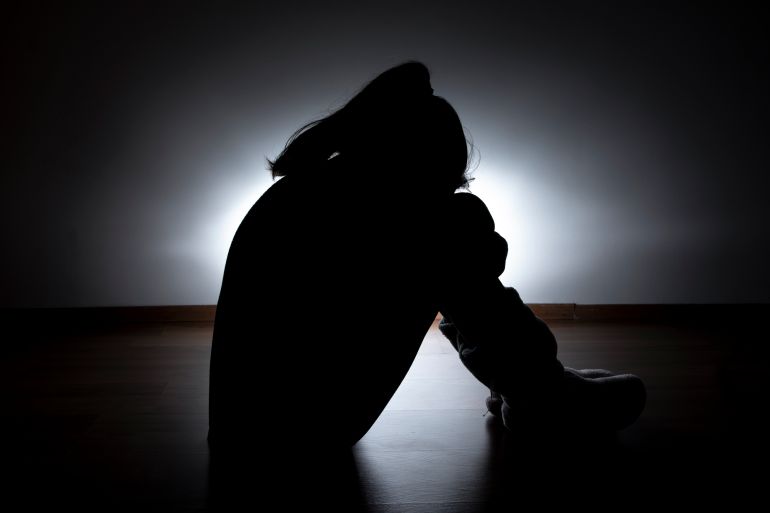It’s time to break the silence on childhood sexual violence
If we fail to do so, millions of children will suffer.

Human instinct tells us to run from awkward conversations.
To shut out what is painful.
Keep reading
list of 4 itemsTen years after Chibok girls kidnapping: One woman’s struggle to move on
Children slide down destroyed Gaza mosque
Why mass kidnappings still plague Nigeria a decade after Chibok abductions
To avoid questions we do not have the answers to.
We are conditioned to believe that certain topics have no place in everyday conversation.
All this breeds taboo, stigma and shame.
As a survivor of childhood sexual violence, today I am asking you to challenge that instinct and talk about something that might make you feel uncomfortable, angry, sad or embarrassed.
Sexual violence against children is a silent global scourge – transcending cultures and crossing borders – and it requires every one of us to break the deafening silence.
We all have a role to play, and it begins with talking.
I started sharing my own story about 13 years ago – not because I like doing it, but because I was done carrying the shame. It is not easy to talk about my experiences – it was not easy then and it still is not easy now – but I do it so that others do not feel alone, as I did.
Because, really, a survivor is never alone. Approximately one in five women and one in 10 men report having been sexually abused as children. That is 20 percent of women and 10 percent of men.
I came forward because I felt like the silence around the issue of sexual violence was deafening, and, despite the prevalence of the crime, there were no survivors at the table.
For over 20 years, I have been advocating on behalf of children and survivors, most recently with Together for Girls – a global partnership to end violence against children and adolescents – and as co-founder of the Brave Movement – a survivor-centred movement mobilising around the globe to ensure survivor voices are heard.
Rooted in three central pillars – prevention, healing and justice – the Brave Movement is demanding action at scale.
And we argue that achieving these three goals starts with breaking the silence.
First, prevention.
Data and evidence tell us that there are interventions that work to prevent violence against children. These include creating child-friendly care centres, empowering young women and adolescent girls, educating children about their bodies, providing parent and caregiver support, creating safeguards in sports and youth-serving organisations, creating a safer internet, and eliminating statutes of limitations so survivors can seek justice if and when they are ready.
Together for Girls is gathering data in over 22 countries to understand the magnitude of the problem – including so far for 20 percent of the world’s children in low-income countries – as well as reviewing evidence globally on the solutions and interventions that work to address it.
As an expert on violence issues and child protection, I know these evidence-based, proven solutions can work to end all forms of violence against children.
But as a survivor, I also know that as long as childhood sexual violence is shrouded in secrecy, it will continue to thrive.
Without breaking the culture of silence that currently exists around childhood sexual violence, we will never be able to bring this data to those who can use it to drive change.
Second, talking is fundamental to healing.
Shame is a complex emotion and one that stays with many survivors of childhood sexual violence for life.
My sexual abuse began at the age of six. I was sexually abused by someone very close to my family and, for many years, I lived in silence. I felt very alone, and I had so much pain and fear.
When I was 15, I watched a movie on TV about a girl who had been sexually abused by her stepfather, and the consequences that had on her life. I remember watching the movie and understanding, for the first time in my life, what had happened to me.
I suddenly realised that I was not alone; this was not an experience that only I had. For the first time, I could make sense of it.
Shame thrives in silence, and the scars it leaves on survivors last a lifetime. But it does not have to be this way. Just by talking and listening, we all have the power to fight stigma and ensure survivors do not feel alone.
Who would not want to use that power?
Finally, breaking the silence ultimately brings justice to survivors.
Silence emboldens and enables predators, keeping them safe in the knowledge that society is too afraid to hold them to account. For too long, survivors have been silenced for fear of not being believed. Undermined due to power imbalances. Deterred because laws don’t sufficiently protect them.
We must normalise speaking up, reporting crimes and ensuring reports are taken seriously. This starts with creating safe spaces for children – and adults – where stigma and shame are left at the door.
Next week, the Brave Movement is mobilising at the European Parliament in Brussels and on Capitol Hill in Washington, DC, to ensure survivor voices are heard as decision-makers review proposed legislation to keep children safe on and offline.
Ending sexual violence against children may seem like an insurmountable task, but it is not if we take collective action and give survivors a seat at the table.
In a world where conversations about childhood sexual violence are normalised, prevention, healing and justice are all achievable.
But if we do not break the silence on this issue we perpetuate the stigma around it.
And stigma disables prevention. Stigma delays healing. Stigma impedes justice.
We can no longer accept this.
The views expressed in this article are the author’s own and do not necessarily reflect Al Jazeera’s editorial stance.
